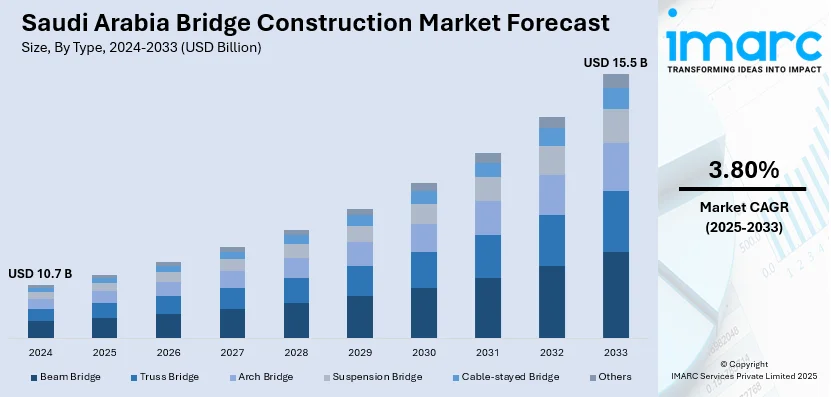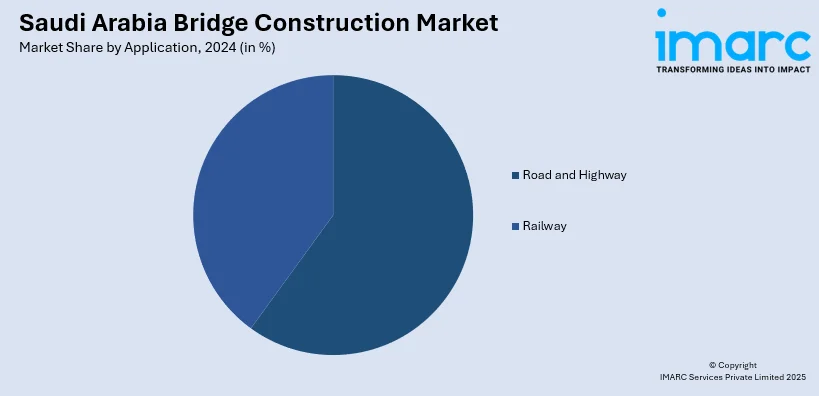
Saudi Arabia Bridge Construction Market Size, Share, Trends and Forecast by Type, Material, Application, and Region, 2025-2033
Saudi Arabia Bridge Construction Market Overview:
The Saudi Arabia bridge construction market size reached USD 10.7 Billion in 2024. Looking forward, IMARC Group expects the market to reach USD 15.5 Billion by 2033, exhibiting a growth rate (CAGR) of 3.80% during 2025-2033. The market is expanding rapidly, driven by Vision 2030 infrastructure initiatives, urban growth, and transport connectivity needs. Moreover, major investments in highways, economic zones, and smart city projects are fueling demand for durable and technologically advanced bridge solutions in Saudi Arabia.
|
Report Attribute
|
Key Statistics
|
|---|---|
|
Base Year
|
2024 |
|
Forecast Years
|
2025-2033
|
|
Historical Years
|
2019-2024
|
| Market Size in 2024 | USD 10.7 Billion |
| Market Forecast in 2033 | USD 15.5 Billion |
| Market Growth Rate 2025-2033 | 3.80% |
Saudi Arabia Bridge Construction Market Trends:
Urban Expansion and Connectivity Needs
Rapid urbanization and the development of new economic zones across Saudi Arabia are increasing the demand for advanced transportation infrastructure, especially bridges. These structures are essential for reducing congestion, shortening travel times, and ensuring seamless movement between expanding residential, commercial, and industrial zones. This ongoing transformation is contributing significantly to the Saudi Arabia bridge construction market growth, as municipal and national planners prioritize connectivity in city expansion plans. Urban centers like Riyadh, Jeddah, and Dammam are witnessing increased investments in bridge projects to link highways, bypasses, and newly established economic districts. For instance, in January 2025, Sinopec entered into an agreement with the Eastern Province Municipality to build a bi-directional bridge measuring 775 meters in length and 34.5 meters in width at the intersection of Jubail-Dhahran Highway and King Abdul Aziz Road. This new bridge aims to improve traffic flow and contribute to the ongoing infrastructure development in Dammam. Additionally, satellite towns and logistics hubs being built under Vision 2030 require reliable bridge networks to support workforce mobility and goods transportation. As Saudi cities grow both horizontally and vertically, these strategic infrastructure initiatives are expected to play a major role in increasing the Saudi Arabia bridge construction market share.

Infrastructure Push Under Vision 2030
Saudi Arabia's Vision 2030 is driving an ambitious infrastructure agenda with large-scale bridge construction as a key driver of national change. Megaprojects such as NEOM, The Line, and Red Sea Global require all-encompassing transport networks that facilitate urban mobility, logistics, and tourism. Bridges are taking on a central role in connecting highways, smart cities, ports, and remote development zones, offering efficient access and movement through challenging terrain. In line with this, in February 2024, China Harbor secured four major projects in Saudi Arabia, including a cable pile repair project at Sugaq Power Plant, a connecting bridge for an artificial island at Jizan Basic Downstream Industrial City, the Laheq connecting road and sea-crossing bridge on the Red Sea, and a high-grade residential project in Riyadh. Government investment, along with public-private partnerships, are accelerating the installation of these critical infrastructures. These bridges are not only being constructed for functionality but are even designed with new materials and technologies to ensure they can last in the long term and are climate resilient. As the construction activities rise according to Vision 2030's timelines, the need for innovative bridge engineering solutions is set to continue rising steadily, aiding the Saudi Arabia bridge construction market outlook in the coming future.
Saudi Arabia Bridge Construction Market Segmentation:
IMARC Group provides an analysis of the key trends in each segment of the market, along with forecasts at the regional level for 2025-2033. Our report has categorized the market based on type, material, and application.
Type Insights:
- Beam Bridge
- Truss Bridge
- Arch Bridge
- Suspension Bridge
- Cable-stayed Bridge
- Others
The report has provided a detailed breakup and analysis of the market based on the type. This includes beam bridge, truss bridge, arch bridge, suspension bridge, cable-stayed bridge, and others.
Material Insights:
- Steel
- Concrete
- Composite Materials
A detailed breakup and analysis of the market based on the material have also been provided in the report. This includes steel, concrete, and composite materials.
Application Insights:

- Road and Highway
- Railway
A detailed breakup and analysis of the market based on the application have also been provided in the report. This includes road and highway and railway.
Regional Insights:
- Northern and Central Region
- Western Region
- Eastern Region
- Southern Region
The report has also provided a comprehensive analysis of all the major regional markets, which include Northern and Central Region, Western Region, Eastern Region, and Southern Region.
Competitive Landscape:
The market research report has also provided a comprehensive analysis of the competitive landscape. Competitive analysis such as market structure, key player positioning, top winning strategies, competitive dashboard, and company evaluation quadrant has been covered in the report. Also, detailed profiles of all major companies have been provided.
Saudi Arabia Bridge Construction Market News:
- In January 2025, Saudi Arabia announced its plans to invest $10.5 million in the construction of the Kurinchakerny Bridge in Eastern Sri Lanka. This investment aims to enhance transportation for approximately 100,000 residents. The funding comes from a previous Saudi initiative and follows a revised agreement with Sri Lanka's Ministry of Finance.
- In August 2024, the Saudi Roads General Authority announced an 88% completion rate for the 3.2 km Safwa-Ras Tanura Bridge in Eastern Province. This project, which includes a land and sea bridge, enhances connectivity to Ras Tanura, Dammam, and King Fahd International Airport and is set for completion by June 2025.
Saudi Arabia Bridge Construction Market Report Coverage:
| Report Features | Details |
|---|---|
| Base Year of the Analysis | 2024 |
| Historical Period | 2019-2024 |
| Forecast Period | 2025-2033 |
| Units | Billion USD |
| Scope of the Report |
Exploration of Historical Trends and Market Outlook, Industry Catalysts and Challenges, Segment-Wise Historical and Future Market Assessment:
|
| Types Covered | Beam Bridge, Truss Bridge, Arch Bridge, Suspension Bridge, Cable-stayed Bridge, Others |
| Materials Covered | Steel, Concrete, Composite Materials |
| Applications Covered | Road and Highway, Railway |
| Regions Covered | Northern and Central Region, Western Region, Eastern Region, Southern Region |
| Customization Scope | 10% Free Customization |
| Post-Sale Analyst Support | 10-12 Weeks |
| Delivery Format | PDF and Excel through Email (We can also provide the editable version of the report in PPT/Word format on special request) |
Key Questions Answered in This Report:
- How has the Saudi Arabia bridge construction market performed so far and how will it perform in the coming years?
- What is the breakup of the Saudi Arabia bridge construction market on the basis of type?
- What is the breakup of the Saudi Arabia bridge construction market on the basis of material?
- What is the breakup of the Saudi Arabia bridge construction market on the basis of application?
- What is the breakup of the Saudi Arabia bridge construction market on the basis of region?
- What are the various stages in the value chain of the Saudi Arabia bridge construction market?
- What are the key driving factors and challenges in the Saudi Arabia bridge construction market?
- What is the structure of the Saudi Arabia bridge construction market and who are the key players?
- What is the degree of competition in the Saudi Arabia bridge construction market?
Key Benefits for Stakeholders:
- IMARC’s industry report offers a comprehensive quantitative analysis of various market segments, historical and current market trends, market forecasts, and dynamics of the Saudi Arabia bridge construction market from 2019-2033.
- The research report provides the latest information on the market drivers, challenges, and opportunities in the Saudi Arabia bridge construction market.
- Porter's five forces analysis assist stakeholders in assessing the impact of new entrants, competitive rivalry, supplier power, buyer power, and the threat of substitution. It helps stakeholders to analyze the level of competition within the Saudi Arabia bridge construction industry and its attractiveness.
- Competitive landscape allows stakeholders to understand their competitive environment and provides an insight into the current positions of key players in the market.
Need more help?
- Speak to our experienced analysts for insights on the current market scenarios.
- Include additional segments and countries to customize the report as per your requirement.
- Gain an unparalleled competitive advantage in your domain by understanding how to utilize the report and positively impacting your operations and revenue.
- For further assistance, please connect with our analysts.
 Request Customization
Request Customization
 Speak to an Analyst
Speak to an Analyst
 Request Brochure
Request Brochure
 Inquire Before Buying
Inquire Before Buying




.webp)




.webp)












